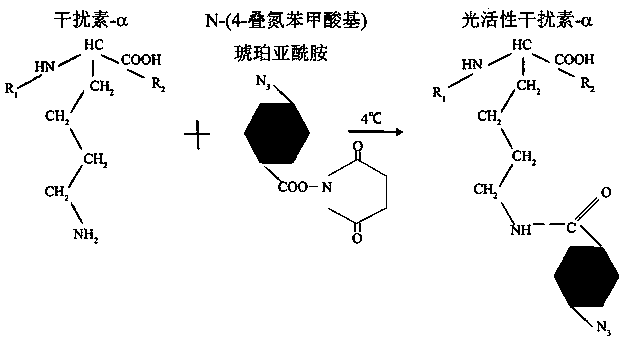Antibacterial and antiviral sanitary pad
A sanitary napkin and antiviral technology, applied in bandages, absorbent pads, medical science and other directions, can solve the problem that sanitary napkins are easily contaminated by bacteria and viruses, and achieve the effects of improving safety, reducing blood circulation and avoiding side effects.
- Summary
- Abstract
- Description
- Claims
- Application Information
AI Technical Summary
Problems solved by technology
Method used
Image
Examples
Embodiment 1
[0049] Embodiment 1: photoactive interferon- alpha preparation and testing
[0050] The synthesis principle of photoactive interferon α is as follows: figure 1 shown. The specific process is as follows: First, prepare 20 mL of DMF / PBS solution according to the volume ratio of 4:1 (weighed by the measuring cylinder and add it to the beaker), and at the same time prepare 7.68x10 -3 mg / mL N- (4-Azidobenzoyl)succinimide in DMF / PBS. Take an autoclaved brown bottle and add 1mL of 7.68x10 -3 mg / mL N- To a solution of (4-azidobenzoyl)succinimide in DMF / PBS, add 5 micrograms of IFN-α, add 4 mL of DMF / PBS solution, and the total reaction volume is 5 mL. Put a magnetic stirring bar into the brown jar and put it into the beaker containing the ice-water mixture. The brown bottle can be wrapped with tin foil (sealing glue), and the temperature is controlled at 4°C. Next, stir in an ice bath for 48h. After the end, ultrafiltration drug: transfer the synthesized drug into a 5mL ult...
Embodiment 2
[0054] Example 2: Preparation and detection of photoimmobilized materials
[0055] Such as Figure 4 As shown, the photoactive interferon-α prepared in Example 1 was grafted on the surface of the dry biological material (sanitary napkin) under the irradiation of ultraviolet rays, and the process should be protected from light. Then the sample is washed with PBS, and the situation of interferon grafting on the surface of the biological material is detected by scanning electron microscopy, and the results are as follows: Figure 5A and Figure 5B shown.
[0056] exist Figure 5A In the scanning electron microscope picture, picture a is a blank ABC pad material, and the enlarged picture c can intuitively find that the surface of this material is relatively smooth; after grafting photoactive drugs, pictures b and d can show that the surface of the material has appeared Nano-scale white small particles, and from the image shows the situation of adsorption on the surface of th...
Embodiment 3
[0059] Example 3: Photoimmobilization of Interferon- alpha Detection of antibacterial ability of materials (film diffusion method)
[0060] The process of film diffusion method is as follows: Figure 6shown. The details are as follows: All experimental supplies are sterilized under high temperature and high pressure, and the Neisseria gonorrhoeae (about half ring) purified on the TM medium plate are picked up with an inoculation loop and placed in sterile saline (2mL), and tested with a McFarland turbidimetric tube. For comparison, the bacterial suspension diluted to about 105 CFU / ml is evenly spread on the surface of the medium with a cotton swab. After culturing for 16 hours, use sterile tweezers to place the grafted side of the six concentrations of materials on the surface of the TM medium. , which is equivalent to simulating the bacterial environment in the body. After acting for 10 hours, transfer each group of materials with Neisseria gonorrhoeae to a new TM mediu...
PUM
 Login to View More
Login to View More Abstract
Description
Claims
Application Information
 Login to View More
Login to View More - R&D
- Intellectual Property
- Life Sciences
- Materials
- Tech Scout
- Unparalleled Data Quality
- Higher Quality Content
- 60% Fewer Hallucinations
Browse by: Latest US Patents, China's latest patents, Technical Efficacy Thesaurus, Application Domain, Technology Topic, Popular Technical Reports.
© 2025 PatSnap. All rights reserved.Legal|Privacy policy|Modern Slavery Act Transparency Statement|Sitemap|About US| Contact US: help@patsnap.com



